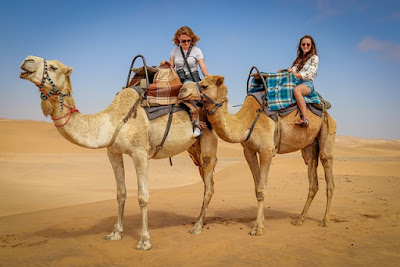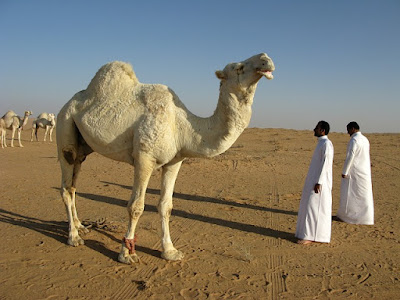Camel: Ship of the Desert
Throughout history, the camel has played an integral role in shaping the lives of various cultures in arid regions of the world. From the deserts of the Middle East to the vast plains of Africa and Asia, these magnificent creatures have been called "ships of the desert" because of their incredible ability to endure harsh conditions and transport goods and people across arid landscapes. In this article, we'll explore the fascinating world of camels, highlighting their unique adaptations, cultural significance, and the vital role they play in the lives of communities living in arid regions.
I. Camel Adaptations: Surviving in the Desert
Camels are truly a marvel of evolutionary adaptation, allowing them to thrive in an environment where many other animals perished. One of the best-known features of camels are their humps, which are not water storage units as is commonly believed, but rather stores of adipose tissue. These humps allow camels to survive long periods without food because they convert stored fat into energy.
In addition, camels have specially adapted feet that spread when walking on sand, preventing them from sinking into the soft desert ground. Their long legs help them cover long distances while reducing heat absorption from the hot sand.
Another extraordinary adaptation is their ability to drink huge amounts of water immediately when water is available. Camels can drink up to 40 gallons (150 liters) of water at a time, allowing them to go without water for days if necessary.
2. Camel in Culture and History:
Bedouin Heritage:
Camels have been an integral part of Bedouin culture for centuries. The Bedouin, the nomadic people of the Middle East, have relied on camels as their primary means of transportation and an important source of sustenance. These resilient animals have allowed the Bedouins to cross vast stretches of desert in search of food, water and trade opportunities, shaping their entire way of life.
Silk Road and Trade:
In ancient times, the camel played an important role in facilitating trade on the Silk Road connecting East and West. Caravans of camels laden with valuable goods such as silk, spices and precious metals traversed the perilous desert routes, fostering cultural exchange and economic growth between civilizations.
Religious Significance:
Camels have important religious significance in some cultures. In Islam, camels are revered for their role in historical events and are mentioned several times in the Qur'an. Camels are sacrificed during the annual Hajj pilgrimage to Mecca, symbolizing Prophet Ibrahim's willingness to sacrifice his son Ismail.
3. Camels today: tourism and conservation:
Even in the modern era, camels continue to be an attraction for tourists visiting desert areas. Camel ride offers a unique and authentic experience, giving travelers a chance to connect with the ancient traditions of the desert cultures.
Additionally, camels are important to the livelihoods of many communities, especially those who live traditional nomadic lifestyles. However, camels, like many other species, face challenges today. Climate change, habitat loss and modernization have affected camel populations and their natural habitats.
Efforts are underway to promote the conservation of these majestic animals and their ecosystem. Governments and non-governmental organizations are working together to protect camel populations and preserve their genetic diversity. In addition, sustainable tourism practices are being encouraged to ensure that camel-related activities do not harm the animals or their environment.
The camel's legacy as the "ship of the desert" continues to inspire awe and wonder in all cultures. Their remarkable adaptation and historical significance make them a symbol of resilience and adaptability in the face of adversity. As we move forward, it is essential to appreciate and protect these magnificent creatures and the ecosystems they call home, while ensuring that generations to come can also marvel at the camel's enduring spirit.
Here are 20 interesting facts about Camel :
- Camels belong to the Camelidae family and are native to arid regions of Africa and Asia.
- There are two main species of camels: the one-humped dromedary camel (Camelus dromedarius), and the two-humped Bactrian camel (Camelus bactrianus).
- The humps on a camel's back are not made of water but of fatty tissue. They serve as energy stores, allowing camels to survive long periods without food.
- A fully grown adult camel can weigh between 1,320 to 2,200 pounds (600 to 1,000 kg).
- Camels have long, slender legs that end in two-toed feet. Each foot has a soft, wide pad that extends to help them walk on sand without sinking.
- The unique shape of a camel's red blood cells allows them to continue flowing even when partially dehydrated, preventing the blood from clotting.
- Camels have a third eyelid called the nictitating membrane, which protects their eyes from blowing sand and harsh desert winds.
- Their wide, tough lips enable them to eat thorny desert plants and thorny vegetation that other animals cannot eat.
- Camels are ruminants, meaning they have a multi-chambered stomach that allows them to efficiently digest their food.
- These desert dwellers can close their noses and ears to keep sand and dust out.
- Female camels are called cows, male camels are called bulls, and young camels are called calves.
- The average age of a camel is about 40 to 50 years.
- Camels are highly social animals and live in groups called herds.
- During the mating season, males behave aggressively to compete for females. They may bite, kick, or neck-wrestle to establish dominance.
- Female camels have a gestation period of about 13 months, and they usually give birth to a single calf, although twins can rarely occur.
- The woolly coat of Bactrian camels helps them tolerate cold temperatures in winter.
- Camels have a strong bond with their handlers and in many cultures, these animals are considered part of the family.
- Camels are employed in a variety of tasks, including transportation, carrying heavy goods, and agricultural activities in arid regions.
- In some countries, camel milk is a traditional beverage, valued for its nutritional properties and potential health benefits.
- Wild camel populations have declined significantly over the years, and many conservation efforts are being made to save these extraordinary creatures from extinction.



Comments
Post a Comment